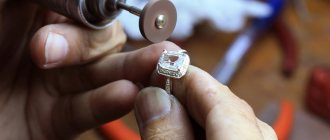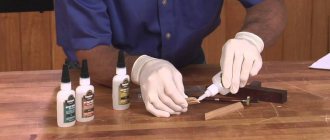Any thing wears out over time and becomes unusable. The same situation applies to wristwatches. Even if you wear them carefully, you still won’t be able to avoid minor scratches on the glass and scuffs on the body. Moreover, such defects not only spoil the aesthetics, but also impede the visibility of the dial. If the scratches are shallow and there are no chips, then you can even polish the glass on your watch yourself, without contacting a watchmaker. If, for example, a child seriously scratched the glass of a watch due to his inattention, then only a master can correct such a defect, perhaps with a complete replacement of the damaged part.
Removing scratches from the case and bracelet of a watch
It is worth warning right away that if it was not possible to avoid deep scratches and chips on a case made of gold, coated with precious metals, a protective special coating or with a satin (matte surface), then you will have to contact the service for professional polishing of the coating - amateur attempts to eliminate these defects can ruin the watch.
Scratches on the watch case
You can polish a wristwatch or a stainless steel metal bracelet yourself, which will require a little time , patience and materials that can be easily purchased in specialized stores.
What materials will be needed?
To polish the case with your own hands you will need :
- polishing cloth intended for polishing jewelry;
- a good brand of cleaner and its analogues;
- manicure block for polishing nails;
- scraps of soft cloth or napkins for wiping glasses.
Polishing can be done on stainless steel watches without bluing, gilding or other coatings. a glossy area does not appear in place of the scratch .
To get rid of minor abrasions and scratches, defective areas are polished with the dark side of a polishing cloth, and then the surface is polished with its light side to a shine (with the exception of the matte case and bracelet).
If the abrasions and scratches are of medium size, then polish the defective areas with a piece of soft cloth , having previously applied a cleaner or its equivalent to it.
The movements must be circular and precisely localized to the scratch site.
Until there is no trace left of it, after which, using a soft cloth or napkin for wiping glasses, the treated area is polished to a shine.
You can also satin the bracelet yourself in a simple way, as evidenced by reviews on the forums. It is usually recommended to use a high-quality eraser (you can use a pencil eraser - it will be convenient) to eliminate scuffs and minor scratches.
Watch polishing eraser
To repair a small chip or deep scratch on uncoated stainless steel, you can use a manicure block to polish your nails , and then polish the top of the case or bracelet.
No matter how carefully you handle your watch, over time it will inevitably develop minor defects in the form of scratches. This not only spoils their appearance, but also makes it difficult to see the position of the hands on the dial. If the glass is scratched, you can use one of the methods below and sand the glass yourself, taking into account the type of material from which it is made.
Polishing in
to describe some important points that relate to such an important aspect of caring for a knife blade - polishing . We will talk about the most modern polishing methods, the products that are currently used and learn how to polish a blade so that it reflects everything around it.
Proper storage, blade sharpness and routine maintenance are very important to extend the life of your knife. Polishing is one of the maintenance stages and this stage is important. What is polishing?
Polishing is the finishing process of an object, which involves extremely smoothing the surface. In this case, various methods of influence are used, as well as many auxiliary tools and special means. Polishing must be carried out, for example, before etching the blade or applying a design.
How does polishing occur, thanks to which the blade acquires that almost ideal reflective ability?
Preparation
It is assumed that the knife blade has already been prepared, that is, it has already passed the first three phases: peeling, sharpening and finishing. This is followed by grinding, during which various irregularities, burrs, and old coating (if any) are removed from the surface. Grinding can be done either manually or using various devices.
After this, you can move on to the final stage - polishing.
Process
In order to achieve an ideal result, you will need to perform a fairly wide range of actions. In addition, it is worth saying that the polishing process takes a lot of time and effort.
If when grinding you can use electrical devices that allow you to achieve the desired result in a relatively short time, then polishing requires a more careful attitude to the surface and in this case you need to use special, low-speed polishing machines and do it yourself.
Main nuances of polishing:
- Using only mechanical action it is impossible to achieve an ideal result, so you have to resort to the help of special chemicals - polishing pastes or liquids .
- All actions are carried out with a constant reduction in the abrasive grain size. The smaller the grain size change step, the better the final result will be.
- Before starting work, you need to separate the blade from the handle, if possible.
- If you use sandpaper, you need to wrap it on a wooden block, so the contact of the abrasive with the surface being treated will be more uniform.
- It is better to start polishing with an abrasive with a grain size of 200-300 units ; you can use any polishing mixture together.
The final processing is carried out with a polishing machine at a speed of no more than 1750. Polishing paste is applied to a fabric or felt disk and carried out with gentle movements over the entire surface of the blade. Often, for polishing more expensive and exclusive knives, after the machine, polishing continues manually, on special wooden blocks using polishing agents.
Today, the market offers a fairly wide selection of polishing pastes with different compositions and for different applications. And only a few companies produce specialized products for polishing knives. One such company is Flitz. This is a world-famous American brand of polishing products that relatively recently appeared in Russia.
Flitz began over 40 years ago as a family business . Ulrich Jens founded the company with his father, mother and wife with the goal of creating high-quality metal polishing products
For the first three years, Flitz products were sold only at various exhibitions. The main goal during the first few years was to increase brand awareness. At first the company was known only within the United States, but now Flitz is known and bought all over the world.
Flitz products are made from high quality ingredients from Germany. Among the company's clients are many well-known companies and manufacturers of knives, equipment and equipment. Let's take a closer look at several products from Flitz.
Flitz Polish polishing paste
Flitz Polish is a concentrated cream that is unsurpassed in its ability to clean, polish, restore and protect. Nothing works faster, easier or better! Non-abrasive, non-toxic, non-flammable, acid-free, non-drying, non-sludge-free!
Suitable for polishing brass, copper, silver, chrome, stainless steel, nickel, bronze, gold, aluminum, tin. Not suitable for galvanic coatings. Removes rust, water stains, oxidation and fingerprints. Do not use on galvanized surfaces.
Characteristics:
- Weight: 150 g
- Acid free
- Non-toxic
- Incombustible
- Manufacturer: Flitz, USA
Flitz Polish polishing liquid
Flitz Liquid Polish is a high performance liquid cleaner and polish. Specially designed to clean and polish with ease and fluid economy. This concentrated formula uses three times less product than other liquids. Does not contain ammonia or abrasives.
Suitable for polishing brass, copper, silver, chrome, stainless steel, nickel, bronze, gold, aluminum, tin. Removes rust, water stains, oxidation and fingerprints. Not suitable for galvanic coatings.
Characteristics:
- Volume: 100 ml
- Acid free
- Non-toxic
- Incombustible
- Manufacturer: Flitz, USA
Flitz Gun/Knife Care Kit
The Flitz Gun & Knife Care Kit is designed to clean, polish and protect knives and guns. Removes and protects from: rust, fingerprints, water stains, gunpowder residue, tree sap, blood, salts!
Included:
- Flitz polish removes rust, fingerprints, powder deposits, water stains and other contaminants on blued, nickel and steel surfaces. Also, this polish is approved by professionals as an excellent cleaning product for hunting knives.
- A water-based spray containing a degreasing agent that removes fingerprints and oily stains.
- The wax works on all surfaces - burnished, nickel-plated, steel, wood, etc.
- A microfiber cloth is perfect for all of the listed cleaning and protective products. This napkin can be washed in a washing machine using a low spin cycle (WARNING: Do not add fabric softener when washing).
Characteristics:
- Does not contain abrasives
- Non-toxic
- Does not burn
- Manufacturer: Flitz, USA
Flitz pastes and liquids are environmentally friendly, non-toxic, water-based products.
Using these products, you can restore the shine to the ship's bell and copper parts of the steering wheel, bring the appearance of your hunting weapon to perfect condition, and polish the blades of your knives to a mirror shine.
Flitz Metal Polish will restore beauty to blades and protect them from corrosion, the negative effects of water and aggressive environments - by creating a protective microlayer on the polished surface.
Polish your knives only with the best products!
How to remove small scratches from organic glass?
Plastic watches and plastic glass (also called organic) are the most budget-friendly options. The disadvantage of such glass is rapid clouding when it is constantly in contact with clothing. To remove scratches from glass at home, you will need:
- GOI paste No. 1;
- abrasive tooth powder or paste or soap;
- soft cloth (preferably microfiber);
- water.
Sequencing:
- Remove the glass from the watch case and carefully remove all dirt from its surface with microfiber.
- Place the clean glass and, constantly wetting it with water, use wave-like movements with equal pressure to polish the glass on the watch until there is no trace of scratches left and the surface becomes matte.
- Soak a little paste or soap in water , apply to the surface of the glass and continue polishing it for another 10-20 minutes.
- Wipe the ground glass clean and place it back into the watch case.
This is how you can polish a scratch on a watch glass, completely eliminating its traces, and the glass will look like new . You can polish the mineral glass of a wristwatch in the same way.
Polishing agents
Effective products for polishing work:
- toothpaste;
- GOI abrasive for polishing work and having a suitable grain size;
- sterile cotton wool in the form of tampons;
- pure alcohol;
- mineral oil;
- grinding machine;
- polishing wheel intended for use with a machine;
- pieces of soft tissue.
Medium scratches
To eliminate medium-depth scratches, you will need the same materials as for small scratches, but GOI paste is not only No. 1, but also No. 2 and No. 3, as well as a piece of leather or felt .
A piece of leather for polishing watches
Steps:
- Remove the glass from the watch case and with microfiber to remove all dirt.
- Apply a little GOI paste to microfiber moistened with water and polish the glass with the same wave-like movements until noticeable scratches disappear, then replace the paste with No. 2 and continue polishing. To eliminate micro-scratches, use paste No. 1.
- When the surface of the glass becomes perfectly matte, wash off the GOI paste, dry the glass with dry microfiber, apply tooth powder or paste to it and continue polishing with microfiber dipped in water for about 15 minutes.
- Clean the glass and put it back into the watch case.
Tooth powder for watch polishing
Paste GOI
Watch glass polishing is effectively done using GOI paste. Even in ancient times, this product was used to clean many surfaces. But there are many fakes, so you should choose products carefully. If you manage to choose a quality product, then you can start doing the work:
- the paste must be melted using a water bath, since it works better when warm;
- to apply the product, use a felt cloth or cotton pad;
- you should wipe the damaged surface, and if it is not cleaned, then do the work again.
Does a great job of removing scratches. Moreover, the product can be left to clean the surfaces of other products.
Removing deep scratches
In addition to the above materials, you will need:
- GOI paste numbers from 1 to 4;
- medium and fine grit sandpaper.
Sequencing:
- Remove the glass from the watch case and clean it with microfiber to remove all dirt.
- Begin polishing in a wave-like motion using medium-grit sandpaper.
- Go to GOI No. 4 to remove the most noticeable irregularities, then to GOI No. 3 and No. 2, and finally to fine-grained sandpaper .
- To eliminate micro-scratches and make the glass matte, use GOI No. 1 for polishing.
- To restore the glass's glossy shine, polish its surface with the same wave-like movements using tooth powder or soap for at least 10-15 minutes.
- Clean the glass and put it back into the watch case.
Sandpaper for polishing watches
How to Polish Copper to a Mirror Shine
To give the best consumer qualities and attractive appearance to metal products, a finishing grinding procedure is carried out. Polishing the metal gives the product a decorative shine; also, performing a similar procedure allows you to prepare the surface for applying various materials.
Metal polishing
Mechanical polishing method
For many years, a mechanical method of processing the surface of a metal product has been used. Special sets of abrasive wheels and belts, when combined with GOI polishing pastes, make it possible to obtain a material with a roughness index Ra = 0.05–0.12 microns.
The features of this password encryption method include:
- to automate the process, special machines are used that are equipped with fabric or felt circles;
- a certain amount of GOI paste is applied to the abrasive;
- the goyi paste in question is a special powder consisting of an active substance that has an activating effect on the surface of the product;
- A typical paste consists of approximately 60% abrasive and 40% binder. content of activating additive 2%.
Finish grinding can only be achieved using GOI paste. In this case, a soft wheel and GOI paste with a fine abrasive are used.
For such work, the material consumption is quite large: per 1 square meter of surface there are 0.3 felt wheels and an abrasive substance such as GOI, approximately 100 grams.
When processing complex surfaces, a belt type of material and the same GOI abrasive are used.
Special attention should be paid to GOI paste. It is a special substance that is based on chromium oxide. The substance from the GOI category is produced in the form of a green bar. Special GOI sets contain bars with different abrasive grain sizes.
Sapphire crystal
Sapphire glass, although it has maximum hardness, is at the same time very fragile. It is best to have it polished by professionals in a watch or jewelry workshop. However, such a need is unlikely to arise, since only extremely hard material, for example, diamond, can leave a scratch on it.
The watches that we constantly use and get used to also need our care. Spend a little time - and they will shine like new, and not a trace will remain of minor scratches.
Sandpaper
If the watch has thick and durable glass, then it is restored on a polishing machine. Partially replacing the equipment will be ordinary sandpaper with medium or fine abrasiveness. Do not use coarse-grained paper - it will cause even more damage.
The surface should be treated similarly to other methods - in circular movements and with equal pressure over the entire area.
Advice If a deep crack appears on the watch, it is better to replace the glass with a new one.











